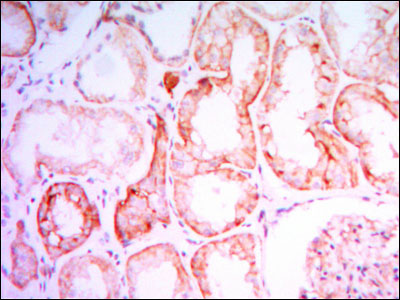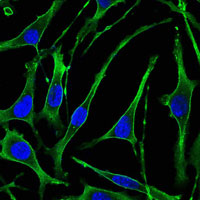PTH1R Antibody
Purified Mouse Monoclonal Antibody
- SPECIFICATION
- CITATIONS
- PROTOCOLS
- BACKGROUND

Application
| WB, IHC, ICC, E |
|---|---|
| Primary Accession | Q03431 |
| Reactivity | Human |
| Host | Mouse |
| Clonality | Monoclonal |
| Clone Names | 4D2 |
| Isotype | IgG1 |
| Calculated MW | 66kDa |
| Description | The protein encoded by this gene is a member of the G-protein coupled receptor family 2. This protein is a receptor for parathyroid hormone (PTH) and for parathyroid hormone-like hormone (PTHLH). The activity of this receptor is mediated by G proteins which activate adenylyl cyclase and also a phosphatidylinositol-calcium second messenger system. Defects in this receptor are known to be the cause of Jansen's metaphyseal chondrodysplasia (JMC), chondrodysplasia Blomstrand type (BOCD), as well as enchodromatosis. Two transcript variants encoding the same protein have been found for this gene. |
| Immunogen | Purified recombinant fragment of human PTH1R expressed in E. Coli. |
| Formulation | Ascitic fluid containing 0.03% sodium azide. |
| Gene ID | 5745 |
|---|---|
| Other Names | Parathyroid hormone/parathyroid hormone-related peptide receptor, PTH/PTHrP type I receptor, PTH/PTHr receptor, Parathyroid hormone 1 receptor, PTH1 receptor, PTH1R, PTHR, PTHR1 |
| Dilution | WB~~1/500 - 1/2000 IHC~~1/200 - 1/1000 ICC~~N/A E~~N/A |
| Storage | Maintain refrigerated at 2-8°C for up to 6 months. For long term storage store at -20°C in small aliquots to prevent freeze-thaw cycles. |
| Precautions | PTH1R Antibody is for research use only and not for use in diagnostic or therapeutic procedures. |
| Name | PTH1R {ECO:0000303|PubMed:10913300, ECO:0000312|HGNC:HGNC:9608} |
|---|---|
| Function | G-protein-coupled receptor for parathyroid hormone (PTH) and for parathyroid hormone-related peptide (PTHLH) (PubMed:10913300, PubMed:18375760, PubMed:19674967, PubMed:27160269, PubMed:30975883, PubMed:35932760, PubMed:8397094). Ligand binding causes a conformation change that triggers signaling via guanine nucleotide-binding proteins (G proteins) and modulates the activity of downstream effectors, such as adenylate cyclase (cAMP) (PubMed:30975883, PubMed:35932760). PTH1R is coupled to G(s) G alpha proteins and mediates activation of adenylate cyclase activity (PubMed:20172855, PubMed:30975883, PubMed:35932760). PTHLH dissociates from PTH1R more rapidly than PTH; as consequence, the cAMP response induced by PTHLH decays faster than the response induced by PTH (PubMed:35932760). |
| Cellular Location | Cell membrane; Multi-pass membrane protein |
| Tissue Location | Expressed in most tissues. Most abundant in kidney, bone and liver. |

Thousands of laboratories across the world have published research that depended on the performance of antibodies from Abcepta to advance their research. Check out links to articles that cite our products in major peer-reviewed journals, organized by research category.
info@abcepta.com, and receive a free "I Love Antibodies" mug.
Provided below are standard protocols that you may find useful for product applications.
References
1. Int J Cancer. 2007 Sep 1;121(5):943-54. 2. Mol Endocrinol. 2008 Jan;22(1):156-66.
If you have used an Abcepta product and would like to share how it has performed, please click on the "Submit Review" button and provide the requested information. Our staff will examine and post your review and contact you if needed.
If you have any additional inquiries please email technical services at tech@abcepta.com.













 Foundational characteristics of cancer include proliferation, angiogenesis, migration, evasion of apoptosis, and cellular immortality. Find key markers for these cellular processes and antibodies to detect them.
Foundational characteristics of cancer include proliferation, angiogenesis, migration, evasion of apoptosis, and cellular immortality. Find key markers for these cellular processes and antibodies to detect them. The SUMOplot™ Analysis Program predicts and scores sumoylation sites in your protein. SUMOylation is a post-translational modification involved in various cellular processes, such as nuclear-cytosolic transport, transcriptional regulation, apoptosis, protein stability, response to stress, and progression through the cell cycle.
The SUMOplot™ Analysis Program predicts and scores sumoylation sites in your protein. SUMOylation is a post-translational modification involved in various cellular processes, such as nuclear-cytosolic transport, transcriptional regulation, apoptosis, protein stability, response to stress, and progression through the cell cycle. The Autophagy Receptor Motif Plotter predicts and scores autophagy receptor binding sites in your protein. Identifying proteins connected to this pathway is critical to understanding the role of autophagy in physiological as well as pathological processes such as development, differentiation, neurodegenerative diseases, stress, infection, and cancer.
The Autophagy Receptor Motif Plotter predicts and scores autophagy receptor binding sites in your protein. Identifying proteins connected to this pathway is critical to understanding the role of autophagy in physiological as well as pathological processes such as development, differentiation, neurodegenerative diseases, stress, infection, and cancer.




